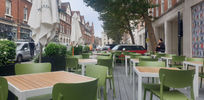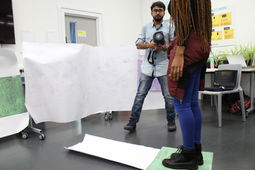top of page

UX of Human Senses
4 Oct - 10 Oct
Back To Top
Design Breif
Design a tool or instrument that enables you to access the
invisible, the unmeasurable, the intangible on London’s streets.
Team

Spotting the invisible
A free wandering mind is a key to generating new ideas, and we started our journey at Bishop Square. We came across mesmerizing artefacts in exhibitions, soothing coffee at coffee shops, heartful churches, lively plants, and cheerful people around. We were able to sense several invisible experiences on the street and became excited about each of them. It was tough to settle for anyone idea beat the rhythm of walking, the magnetic attraction of artefacts and people, UV light effects on London, bonding between random people, emotions on experiencing London.

Spotting the invisible
We were sitting at the coffee house and brainstorming on ideas while one by the other people were passing by us, and we were able to hear the sound of their feet tapping on the road. So we heard a spectrum of sounds generated with different footwears tapping at different paces and realized that London itself is a country with more and more people walking on the streets.
"And we spotted the invisible rhythm of life on the streets of London."
Diving deep into Rhythm of walking
The rhythm of walking is associated with intrinsic and extrinsic factors. It was fascinating to see how people walked at different paces while some even had unconscious synchronized footfalls. The cohesive sound of foot-tapping on profuse surfaces generated synchronous and asynchronous rhythms that even felt like music.

Factors affecting walking rhythm
Altering the rhythm with music
At one point, we were experimenting if extrinsic factors like music change the walking rhythm. However, later we realized it was a diversion.
Capturing & reflecting the rhythm
Now we had the challenge to capture actual foot sounds without making people conscious in the street. We went to the creative technology and sound lab with the idea of having mics that can pick up feet sounds while walking and a piece of software that could separate the background noises. We learned about contact mics and a few software that can generate real-time visualizations based on captured audio. Interestingly, our on-street experience with people walking also makes us think towards generating music out of the rhythm by mapping instruments to footsteps in the FL studio. While all the ideas were unique, this would need more than a week.
It was time for us to course-correct our design directions and go back to the basics. So we began to experiment with amplifying the foot sound to capture the relative rhythm of walking. We tied a jar of gum on one of our mate's legs and tried to experience her walking rhythm in our college building.

With peer feedback, we realized that walking rhythm could also be measured as the number of footprints falling over a specific area within a specific time. We were in deep thoughts about how best we could capture the footprints and started exploring with materials. We used paper as our medium to try and capture footprints just by walking on it, but the prints were very light and were not visible at all. Later on, we got the idea of using colours beneath footwear as solid mediums to capture prints on paper.
Exploring color and paper
Within colour, as a medium, it was not easy to choose between watercolours, pastel colours, chalk colours, etc. While watercolours could have been a great medium, they came with the implication of spoiling the people's footwear. So we did trial and error with dry and wet chalk powders on papers from our notebook.
"People change their behaviour when they are being observed --- The Hawthorne effect"
Having researched the Hawthrone effect, we wanted to reduce the change in behaviour. The color of paper in the context of the environment could also make people conscious about whether to walk on it or not. Keeping all these challenges in mind, we explored various textures, quality, and colour of papers available in long rolls allowing us to capture more footfalls effectively.


Performing the activity
We conducted the activity simultaneously at three different locations, London Eye, Geraldine Mary Park, and London College of communication, within 4 pm to 4:30 pm. This was done to make people experience the difference in walking pace according to context and environment.

Presentation
In the experience, we immersed people with the surrounded visuals and audio played while we also engaged them by letting them record their own pace live.
Presntation feedback
Could have focused more on the time aspect
Could be more immersive with headphones
Play with materials other than paper
Citations
Wickström, G. and Bendix, T., 2000. The" Hawthorne effect"—what did the original Hawthorne studies actually show?. Scandinavian journal of work, environment & health, pp.363-367.
bottom of page




































.png)
.png)
.png)
.png)